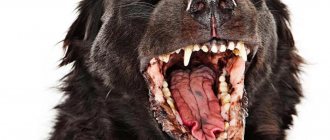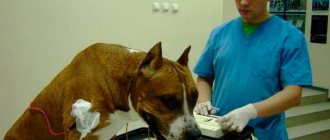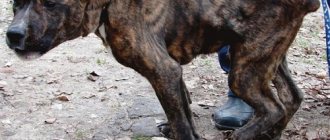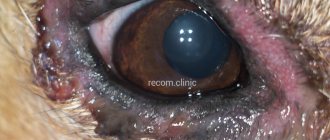Rabies acts as an acute viral pathology that develops in a dog or a person it has bitten. The insidiousness of this disease is that it may not manifest itself in any way even when infection has already occurred. But from the moment the first signs of the disease appear, hopes for a full recovery are diminishing. Therefore, it is important to promptly identify canine rabies, as well as recognize signs of this condition in a person who has been bitten.
How does a dog become infected with rabies?
Any domestic dog that is not vaccinated against rabies can be infected with the disease. Many animals can be the source of the spread of a disease such as rabies. Often, domestic and street dogs become infected after contact with:
- foxes;
- wild boars;
- skunks;
- raccoons;
- wolves;
- bats and so on.
With this disease, it increases, thereby causing the sick animal to behave inappropriately. A sick animal may attack various inedible objects and exhibit excessive aggressiveness. It is not afraid of loud screams and pain.
A domestic dog, when faced with a wild carrier of a dangerous virus, defending its territory, often enters into a fight with it. When a rabid animal inflicts wounds, it introduces its saliva, which contains the virus, into them. The blood, secretions and meat of a sick animal are contagious. Even if there are no open wounds, the virus can enter the dog’s body through saliva when it comes into contact with the mucous membranes of the mouth or eyes.
About 2 days before obvious neurological symptoms appear, the virus begins to be excreted in the saliva and feces of sick animals. During this period they are extremely dangerous to others.
Rabies - symptoms and treatment
The main means of preventing the spread and disease of rabies is the implementation of a number of preventive measures to reduce the risks of infection and development of the disease.
There are measures aimed at preventing the spread of rabies in nature (both wild and anthropological environments):
- regulation of the number of wild and feral domestic animal predators (catching, shooting, vaccination);
- compliance with the rules for keeping dogs, cats and fur-bearing animals;
- compulsory vaccination against rabies of domestic animals, especially dogs and cats, preventive vaccination of persons associated with constant contact with animals;
- prohibition of communication between domestic animals and strays;
- avoiding direct contact with wild animals that have entered the farmstead;
- regulation of the number of rodents that serve as food for predatory animals.
If there is a meeting with an animal and subsequent direct salivation of damaged skin (mucous membranes) or a bite, it is necessary to carry out a set of preventive measures aimed at preventing potential infection with the rabies virus and the development of the disease.
First of all, it is necessary to evaluate and record:
- what kind of animal did you encounter (wild, domestic);
- what is his behavior (appropriate to the situation, aggressive, overly friendly);
- is it possible to monitor it - this is very important: you cannot kill or drive away the animal, since basic observation of the behavior of the animal up to 10 days after the bite allows you to exclude rabies with a 100% probability (if there is no death or change in behavior, you can calmly exhale and forget about the incident).
If possible, the animal is taken to the veterinary service for examination and quarantine for up to 10 days; if the animal dies, a rabies test must be carried out.
As soon as possible after a bite, it is necessary to wash the wound with a concentrated soap solution and immediately contact the nearest medical institution (trauma department, rabies office) to consult a rabies doctor and determine the indications for rabies vaccination and its volume. In this case, the presence or absence of cases of rabies in the area, the identity of the animal, its behavior, the presence of preventive vaccinations against rabies, the nature and location of injuries, etc. will be important.
Myths and unnecessary fears about the possibility of infection in absolutely impossible situations or, on the contrary, downplaying the risks in a truly dangerous situation are quite common. Therefore, such incidents should not be left to chance ; it is necessary to present all the facts to the doctor at the appointment and jointly make the right decision.
Consultations on correspondence Internet portals are a good start, but they are often carried out by specialists who do not have the proper education and understanding of the problem; it is impossible to assess some important points there, so in no case should you replace a face-to-face consultation with a radiobiologist with the advice of an “uncle” from TV . Remember that the penalty for a wrong decision in this case is death!
The only highly effective method of preventing the development of the disease and preserving human life is vaccination.
Depending on the degree of risk, the administration of rabies immunoglobulin (at high risk) in combination with rabies vaccines is practiced. All rabies vaccines are interchangeable; in the Russian Federation, up to six doses of the vaccine are allowed; in other countries, the course may differ slightly depending on the vaccine.
The administration of vaccines must be carried out strictly according to the schedule approved by the manufacturer and the attending physician. Departure from the regimen threatens disruption of antibody production and death.
It should be especially noted that there are no absolute contraindications to rabies vaccination. If there are any diseases or conditions that prevent the procedure from being carried out, it must be performed in a hospital under the supervision of medical personnel and under the protection of anti-allergic and other means.
The earlier the vaccination course is started, the greater the chances of a favorable outcome of the situation, therefore the main correct action after a dangerous situation is to immediately visit a radiobiologist in person, who will analyze the situation and make a responsible decision.
As a rule, vaccination does not lead to any negative consequences, the most pronounced of which are moderate pain and sensitivity in the injection area and allergic reactions, which are quite easily controlled by appropriate means.
During vaccination, you should avoid excessive stress on the body, taking immunosuppressive drugs (if possible), drinking alcohol (there are cases of going on a long binge and skipping vaccinations), since debilitating and immunosuppressive effects can weaken the production of protective antibodies and cause vaccination failure .
After completing the course, all restrictions are lifted, since by this time an adequate level of immunity has been formed and the virus has died.[1][3]
Symptoms that appear after a rabid dog attack
Development of rabies in humans
A rabid dog bite is rarely a single bite. In most cases, the animal cannot be driven away, but it attacks again and again. Even if a small amount of saliva gets on the damaged skin and the wound is treated, this does not guarantee that the victim will not get sick. The first signs of rabies in a person do not appear earlier than 10-15 days after the bite.
The risk of developing rabies after being bitten depends on the person's age, the nature of the skin damage, the location of the bites and the amount of virus ingested. In some people, the disease does not develop, while in others, all manifestations of rabies develop in just a month, and in the shortest possible time, respiratory arrest and disruption of the functioning of other organs due to damage to the central nervous system are possible.
Urgent Care
Rabies in humans and symptoms of a dog bite that indicate infection can be prevented by taking immediate measures.
The correct actions are as follows:
- if there is bleeding, wait a few minutes for the dog’s saliva to come out with the blood - this way, significantly less infection gets into the wound. If the damage is small, then lightly compress the wound until blood appears;
- rinse the bite under running cool water with the addition of laundry soap - the alkaline environment destroys many bacteria and reduces the risk of inflammation. Deep punctures are cleaned with a syringe using 3% hydrogen peroxide. Washing should be carried out intensively;
- treat the wound with an available antiseptic (furacilin, miramistin, chlorhexidine);
- apply a sterile napkin with a solution and bandage the wound;
- apply cold to the affected area.
If necessary, the victim should take a pain reliever. Doctors do not recommend cauterizing wounds or suturing them. Such measures lead to the development of complications.
When you realize how dangerous a rabid dog bite is for a person, it is important not to delay a visit to a traumatologist. If a child or elderly person has been injured, you should visit a doctor on the day of the injury.
During the examination and thorough treatment of the wound with medications, the doctor should be informed about what is known about the biting dog, its behavior, the presence of vaccination, and the circumstances of the attack. Based on the totality of data and the clinical picture of the injuries, a decision is made on further actions.
As a rule, after first aid is provided, the victim is given a vaccine and sent home with subsequent consultations and scheduled vaccination days. The doctor tells how rabies from a dog bite manifests itself if vaccination days are missed and treatment is neglected. An inpatient stay is possible in case of extensive lacerations and the need for surgical assistance in applying primary sutures.
How does the disease develop in humans?
Stages of development of rabies in humans
Infection from the bites of dogs suffering from rabies occurs in several stages. The virus first enters the human body through the saliva of an infected animal. With deep wounds, it immediately penetrates the bloodstream. After this, the incubation period begins, which can last from 2 weeks to 6 months. In rare cases, the first symptoms appear within one year.
After completion of the incubation period, the disease proceeds in 3 stages. Each of them is characterized by a set of acute symptoms. At the first stage of the onset of the disease, signs of damage to the central nervous system increase, as the virus rapidly multiplies and spreads along the nerve pathways. This stage takes from 1 to 3 days. During this period of development of pathology, the patient may be concerned about:
- pain at the site of the bite, even if the skin has completely healed;
- irritability;
- headache;
- fatigue;
- vomit;
- rapid weight loss;
- fever;
- muscle pain;
- increased body temperature;
- restless sleep.
The second stage of rabies lasts from 3 to 5 days. During this period of disease development, the patient's condition rapidly deteriorates. The following signs of inflammatory damage to the tissues of the central and peripheral nervous system appear:
- spasms at the sight of water and food;
- rabies;
- photophobia;
- convulsions from sharp sounds;
- panic attacks;
- increased aggressiveness;
- hallucinations;
- rave.
During this period of development of pathology, the patient is potentially dangerous both for himself and for others. He can get into fights and bite, hitting his head and other parts of his body on various surfaces. When the pathology passes into the third phase of development, a person suffering from rabies calms down. He develops rapidly progressive muscle paralysis. After this, a disturbance in the heartbeat and breathing occurs. This disease, even with targeted treatment, is fatal. The average life expectancy of people with rabies is 12 days.
Signs of rabies in dogs
There are general and specific manifestations. Here are the main behavioral traits by which you can recognize that your pet is sick:
- skinny appearance;
- increased salivation from the mouth;
- tongue hanging out;
- likely to develop strabismus;
- clouding of the corneal element;
- paralysis of limbs.
As for private signs, they depend on one form or another of the disease.
Violent form of the disease
This type of disease is characterized by the following distinctive features:
- duration – 5-11 days;
- division into prodromal (up to 3 days), manic (same duration) and paralytic (up to a week) stage;
- apathy and desire to hide from others;
- excessive thirst for affection, licking the owner’s hands;
- at the next stage aggression develops;
- attack “silently” without previous barking;
- paralysis of the laryngeal region;
- at the last stage – problems with swallowing;
- coma.
Quiet variety
This is an atypical variant of the development of the disease. The dog does not behave aggressively, there is no loss of appetite. There is a possibility of difficulty swallowing. They are similar to the situation when an animal chokes on a bone. Paralysis of the pharynx and lower jaw occurs, and subsequently they lose motor functions and the hind limbs.
Return form
In this case, symptoms and remissions are observed in cycles. At one time, it seems that the dog has completely recovered, but after 2 weeks the signs of this disease make themselves felt again. The set of symptoms remains the same, and they consist of attacks of apathy, aggression, and paralysis.
After all these signs have passed, the animal becomes completely paralyzed and dies.
First aid for bites
Wound after a dog bite
Considering that after the first symptoms of rabies appear, treatment is impossible, it is necessary to take measures immediately after bites by such animals to prevent the development of pathology.
First of all, the wound should be washed with running water and soap. The skin around the wound is treated with alcohol or brilliant green. If the bleeding is not severe and does not threaten the life of the victim, it should not be stopped, since it helps wash out infected saliva from the wound. After this, you should immediately go to the emergency room, because only a doctor can prescribe the correct treatment for a rabid dog bite.
If a person is bitten by a dog, they try to catch the dog alive. Observing such animals for 10 days allows us to accurately determine whether they have rabies. If during this period the signs characteristic of the disease do not appear, then the reason for the attack may lie in natural aggressiveness.
What to do if a dog bites a child?
Often children from 5 to 14 years old encounter rabid animals, who do not know the signs of the disease and cannot quickly orient themselves and leave a potentially dangerous place. Children under 5 years of age are less likely to encounter sick dogs.
If a child is bitten, the wound is thoroughly washed and treated with aseptic solutions. If the animal does not have obvious signs of rabies, it should be isolated if possible. Children who have been bitten by dogs must be taken to the emergency room for professional treatment of the wound.
Often, in case of severe damage, not only external treatment of the wound with immunoglobulin is performed, but also sutures are applied. To reduce the risk of contracting rabies, children, like adults, may be eligible for rabies and tetanus vaccinations.
Treatment for a dog bite
Treating a wound after a bite
Therapy for a dog bite should be carried out under the supervision of a doctor, since the contents of a dog’s saliva may contain not only the rabies virus, but also other equally dangerous pathogenic microflora. At the emergency room, the doctor will treat the wound with a special anti-rabies liquid, that is, immunoglobulin. This will reduce the risk of spreading infection and developing rabies in humans.
If suturing is necessary, the damaged area is carefully treated with antibacterial ointment. Lastly, a loose sterile bandage is applied. General-spectrum antibiotics may be included in the treatment regimen to prevent wound infection. In the future, the patient must come to the hospital for dressing and treatment of the affected area.
If there is no accurate evidence that the animal was healthy, a course of rabies vaccination may be prescribed for prevention purposes. The most commonly used vaccines to prevent the development of rabies in humans are:
- Inactivated UPL.
- Inactivated by phenol.
- Vero Cell.
- Abhyarab.
- Diploied.
- Purified Chic Enbryo.
6-7 injections are enough. The first injection is performed in the first hours after infection. The next injection is performed 3 days after the bite. After this, the patient should come to see the doctor in a week. The next injection is given after 14 days. The last 2 injections are performed 30 days later, and then 3 months after the bite.
Despite the fact that injections after a dog bite are not mandatory and are carried out at the request of the victim, you should not refuse them. Once the disease enters the active phase and clear symptoms of rabies appear, it is no longer possible to correct the situation.
The patient is placed in a hospital and given medications to relieve acute symptoms, but this is only palliative treatment, that is, it does not improve the patient’s general condition and achieve recovery.
Prevention
Considering that stray dogs are often carriers of the rabies pathogen and may encounter wild animals in search of food, first of all, efforts should be directed at catching them and placing them in special reception centers. Reducing the number of stray dogs reduces the risk of spreading infections.
Bites
Dogs that are in constant contact with a person rarely attack him, but this cannot be ruled out. Animals after puberty are especially dangerous. Dogs instinctively defend their territory, which can even lead to an attack on their own owner.
Rabies. Safety rules for children
As part of prevention, castration of animals that are not planned to be used in breeding work in the future is necessary. From an early age, a domestic dog should be taught to stay in its own yard, if we are talking about a private home. When walking, you need to take the animal to a specially equipped area. To reduce the risk of bites you should not:
- separate fighting dogs;
- approach animals while eating;
- waking up a sleeping dog;
- take puppies away from a nursing bitch.
Castration and sterilization are an effective measure to prevent an increase in the number of stray animals. To prevent bites, you should avoid places where stray animals gather. It is advisable to carry with you a special repeller, a stun gun or a gas spray, which can be used if the dog decides to attack.
Rabies - how dangerous the disease is
The disease is caused by a virus. When infected through bites or salivation of the skin and mucous membranes, a kind of encephalitis develops - damage to the central nervous system. The disease always ends in death.
The source of the disease is infected animals (dogs, cats, foxes, badgers, herbivores, wolves, etc.). In the structure of morbidity, dogs are the main source of infection in humans.
In nature, there are epizootic foci of rabies among wild animals. Pets become infected mainly when they are bitten by wild animals. Mostly dogs or cats become infected when they walk in the forest or forested area. Pets that are raised correctly by their owners and walked only on a leash rarely become infected with rabies. But stray and ownerless dogs, as well as dogs that are not kept on a leash by their owners, can very often become infected.
Humans are a biological dead end for the rabies virus. A person with rabies is not dangerous to another person.
It should be noted that the rabies virus is relatively stable in the external environment. So in dried saliva it can be preserved for up to 1-2 months; when boiled, it dies within 2 minutes. It also quickly dies under the influence of ultraviolet rays (in the sun) and under the influence of disinfectant solutions.
The period from the moment of infection to the appearance of the first clinical symptoms lasts 1-3 months, the deadlines range from 10 days to 1 year.










